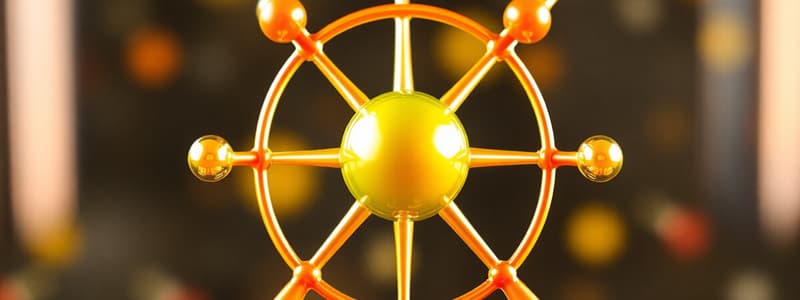Podcast
Questions and Answers
What is the primary taste characteristic of a base?
What is the primary taste characteristic of a base?
- Sour
- Bitter (correct)
- Salty
- Sweet
Acids and bases, when mixed, always produce carbon dioxide.
Acids and bases, when mixed, always produce carbon dioxide.
False (B)
What is the principle of conservation of mass?
What is the principle of conservation of mass?
Matter is neither created nor destroyed, only rearranged.
The organism responsible for photosynthesis converts water and carbon dioxide into blank and oxygen.
The organism responsible for photosynthesis converts water and carbon dioxide into blank and oxygen.
Match the following reactions with their corresponding products:
Match the following reactions with their corresponding products:
Which of the following best describes an exothermic reaction?
Which of the following best describes an exothermic reaction?
The peripheral nervous system (PNS) includes the brain and spinal cord.
The peripheral nervous system (PNS) includes the brain and spinal cord.
Name the two systems responsible for regulating temperature in the body.
Name the two systems responsible for regulating temperature in the body.
Flashcards
Atomic Structure
Atomic Structure
The arrangement of protons, neutrons, and electrons within an atom, including the nucleus and electron shells.
Acid-Base properties
Acid-Base properties
Acids taste sour, are corrosive, and release hydrogen ions (H+); bases taste bitter, feel soapy, and release hydroxide ions (OH-).
Chemical Equation
Chemical Equation
A representation of a chemical reaction using symbols for reactants and products.
Conservation of Mass
Conservation of Mass
Signup and view all the flashcards
Photosynthesis
Photosynthesis
Signup and view all the flashcards
Respiration
Respiration
Signup and view all the flashcards
Combustion Reaction
Combustion Reaction
Signup and view all the flashcards
Exothermic Reaction
Exothermic Reaction
Signup and view all the flashcards
Study Notes
Atomic Structure and Properties
- Draw the structure of an atom, including proton, neutron, electron locations and shells.
- Use the periodic table to identify atomic number, atomic mass, and element symbol.
- Know the properties of acids and bases, and identify indicators.
Acids and Bases
- Bases: Taste bitter, feel soapy/slippery, contain hydroxide ions (OH⁻).
- Acids: Taste sour, corrosive, contain hydrogen ions (H⁺).
Chemical Reactions
- Write word equations for simple chemical reactions, identifying reactants and products.
- Understand conservation of mass (matter is neither created nor destroyed).
- Distinguish between exothermic and endothermic reactions (energy release vs. absorption).
- Identify combustion reactions (hydrocarbon + oxygen → carbon dioxide + water).
- Identify metal oxidation (metal + oxygen → metal oxide).
Chemical Equations and Reactions
- Write word equations for chemical reactions, including acid-carbonate, acid-metal, acid-base reactions.
Biological Processes
- Photosynthesis: Water + carbon dioxide + energy → sugar + water
- Respiration: Oxygen + glucose → carbon dioxide + water + energy
- Understand the link between photosynthesis and respiration.
Systems and Processes
- Identify products and types of radioactive decay.
- Compare the nervous and endocrine systems.
- Understand the reflex arc and feedback loops.
Biological Systems
- Know the peripheral nervous system (PNS) and central nervous system (CNS).
- Know the organs of the excretory/urinary and respiratory systems.
- Understand how the nervous and endocrine systems regulate body temperature.
- Understand half-life graphs.
Studying That Suits You
Use AI to generate personalized quizzes and flashcards to suit your learning preferences.




